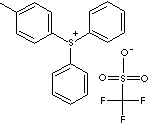(4-METHYLPHENYL)DIPHENYLSULFONIUM TRIFLATE
PRODUCT IDENTIFICATION

Diphenyl-4-methylphenylsulfonium trifluoromethanesulfonate;
CLASSIFICATION
PHYSICAL AND CHEMICAL PROPERTIES
101 - 102 C
REFRACTIVE INDEX
GENERAL DESCRIPTION & APPLICATIONS
Photoacid generators (or PAGs) are cationic photoinitiators. A photoinitiator is a compound especially added to a formulation to convert absorbed light energy, UV or visible light, into chemical energy in the form of initiating species, viz., free radicals or cations. Cationic photoinitiators are used extensively in optical lithography. The ability of some types of cationic photoinitiators to serve as latent photochemical sources of very strong protonic or Lewis acids is the basis for their use in photoimaging applications. The continuing decrease in device dimensions in the microelectronics industry is being achieved by pushing the limits of optical lithography. In chemically amplified resist technology, the radiation-sensitive material (resist) in which patterns are delineated typically includes a matrix polymer and an onium salt photoacid generator (or PAG). There are several materials’ issues to be considered in the choice of the PAG: sufficient radiation sensitivity to ensure adequate acid generation for good resist sensitivity, absence of metallic elements, temperature stability, etc.
The usual photo-supplied catalyst has been strong acid. Triarylsulfonium and diaryliodonium salts have become the standard PAG ingredients in CA resist formulations, because of their generally easy synthesis, thermal stability, high quantum yield for acid (and also radical) generation, and the strength and nonvolatility of the acids they supply. Simple onium salts are directly sensitive to DUV, X-ray and electron radiations, and can be structurally tailored, or mixed with photosensitizers, to also perform well at mid-UV and longer wavelengths. However, onium salts are ionic and many will phaseseparate from some apolar polymers, or not dissolve completely in some casting solvents. Nonionic PAGs such as phloroglucinyl and o,o-dinitrobenzyl sulfonates, benzylsulfones and some 1,1,1-trihalides are more compatible with hydrophobic media in general, although their thermal stabilities and quantum yields for acid generation are often lower.
The phenomenal rate of increase in the integration density of silicon chips has been sustained in large part by advances in optical lithography – the process, as described above, that patterns and guides the fabrication of the component semiconductor devices and circuitry. Although the introduction of shorter-wavelength light sources and resolution enhancement techniques should help maintain the current rate of device miniaturization for several more years, a point will be reached where optical lithography can no longer attain the required feature sizes. Several alternative lithographic techniques under development have the capability to overcome these resolution limits – EUV, X-ray, electron beam and ion beam lithographies, but, at present, no obvious successor to optical lithography has emerged. (source: http://www.sigmaaldrich.com/)
|
Photoacid |
CAS RN. |
|
Diphenyliodonium nitrate |
722-56-5 |
|
Diphenyliodonium p-toluenesulfonate |
6293-66-9 |
|
2-(4-Methoxystyryl)-4,6-bis(trichloromethyl)-1,3,5-triazine |
42573-57-9 |
|
Diphenyliodonium hexafluorophosphate |
58109-40-3 |
|
Triphenylsulfonium triflate |
66003-78-9 |
|
Diphenyliodonium triflate |
66003-76-7 |
|
(4-Methylphenyl)diphenylsulfonium triflate |
81416-37-7 |
|
Bis(4-tert-butylphenyl)iodonium triflate |
84563-54-2 |
|
N-Hydroxynaphthalimide triflate |
85342-62-7 |
|
Triarylsulfonium hexafluorophosphate salt |
109037-77-6 |
|
(4-Phenylthiophenyl)diphenylsulfonium triflate |
111281-12-0 |
|
(4-Methoxyphenyl)diphenylsulfonium triflate |
116808-67-4 |
|
Bis(4-tert-butylphenyl)iodonium p-toluenesulfonate |
131717-99-2 |
|
Tris(4-tert-butylphenyl)sulfonium triflate |
134708-14-8 |
|
Diphenyliodonium 9,10-dimethoxyanthracene-2-sulfonate |
137308-86-2 |
|
Triphenylsulfonium perfluoro-1-butanesufonate |
144317-44-2 |
|
(4-tert-Butylphenyl)diphenylsulfonium triflate |
145612-66-4 |
|
(4-Fluorophenyl)diphenylsulfonium triflate |
154093-57-9 |
|
Boc-methoxyphenyldiphenylsulfonium triflate |
180801-55-2 |
|
(4-Methylthiophenyl)methyl phenyl sulfonium triflate |
187868-29-7 |
|
Diphenyliodonium perfluoro-1-butanesulfonate |
194999-82-1 |
|
Bis(4-tert-butylphenyl)iodonium perfluoro-1-butanesulfonate |
194999-85-4 |
|
(4-Phenoxyphenyl)diphenylsulfonium triflate |
240482-96-6 |
|
Tris(4-tert-butylphenyl)sulfonium perfluoro-1-butanesulfonate |
241806-75-7 |
|
(4-Bromophenyl)diphenylsulfonium triflate |
255056-44-1 |
|
(tert-Butoxycarbonylmethoxynaphthyl)-diphenylsulfonium triflate |
255056-48-5 |
|
(4-Chlorophenyl)diphenylsulfonium triflate |
255056-43-0 |
|
(4-Iodophenyl)diphenylsulfonium triflate |
255056-46-3 |
|
N-Hydroxy-5-norbornene-2,3-dicarboximide perfluoro-1-butanesulfonate |
307531-76-6 |
APPEARANCE
100 - 102 C
236 nm